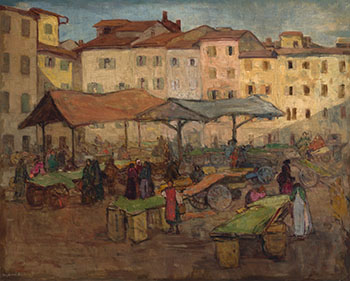Regina Seiden, later known as Regina Seiden Goldberg, was an influential figure in Canadian art during the early 20th century. Born on July 4, 1897, in Rigaud, Quebec, Seiden's journey as an artist began at a young age and continued through a period of remarkable achievement before she eventually paused her career to support her husband's work. Her legacy, however, endures in the rich body of work she left behind, which continues to be celebrated in Canadian art history.
Early Life and Education
Regina Seiden's artistic inclinations were nurtured from a young age. In 1905, at the age of eight, she moved with her family to Montreal, where she attended the Académie Marie-Rose, a French Catholic school. It was here, between 1905 and 1912, that Seiden's talent for painting was first recognized and encouraged, particularly by the Sisters of the academy and her supportive mother.
Seiden's formal artistic training began in 1912 when she enrolled at the Art Association of Montreal (AAM), where she studied under prominent artists William Brymner and Maurice Cullen. Her time at the AAM was marked by significant achievements. Seiden won several awards, including a bursary in 1915, a prize for drawing and open-air painting in 1917, and the prestigious Robert Reford Prize on multiple occasions between 1916 and 1919. These accolades highlighted her exceptional skills and positioned her as a rising star in the Canadian art scene.
Beaver Hall Group and Early Exhibitions
Regina Seiden was a key member of the Beaver Hall Group, an association of Montreal artists that played a crucial role in the development of modern art in Canada. Seiden participated in both of the group's annual exhibitions, showcasing her distinctive style that blended figurative work with a keen sense of decorative composition. In 1921, her work was described as "charming decorative compositions" by La Presse, with The Gazette noting the presence of dancers in her paintings. The following year, she presented "studies" that further solidified her reputation as a talented painter.
Her work during this period primarily focused on portraits, particularly of women, as well as landscapes and genre scenes. Seiden's ability to capture the essence of her subjects with sensitivity and grace earned her admiration from critics and the public alike. Her paintings were soon acquired by major Canadian institutions, including the National Gallery of Canada, which purchased her portraits Rae Kirsch in 1919, Dora in 1924, and Nudes in 1926.
Paris and Artistic Growth
Encouraged by her mentors, particularly William Brymner, Seiden moved to Paris in 1921 to continue her studies at the Académie Julian. This experience allowed her to immerse herself in the vibrant art scene of the French capital, where she further honed her skills and expanded her artistic horizons. During her time in Europe, Seiden traveled to Florence and Venice, where she painted and absorbed the influences of the Old Masters.

Upon her return to Montreal in 1922, Seiden rented a studio on McGill Avenue and continued to focus on portrait painting, often working with live models. Her commitment to her craft and her continued participation in major exhibitions, including the AAM's Spring Exhibitions and the Royal Canadian Academy of Arts' annual shows, ensured that her work remained in the public eye.
Marriage and Artistic Hiatus
In 1926, Seiden returned to Paris for a second time, where she met the German painter Eric Goldberg. The two artists formed a deep connection, and they married in Montreal in 1928. Following her marriage, Seiden made the difficult decision to step away from her own artistic career to support her husband's work. Although she stopped painting professionally, her passion for art never waned, and she continued to be involved in the art community.
Later Life and Legacy
After a long hiatus from painting, Regina Seiden returned to the art world following the death of her husband in 1969. She began teaching art classes at the Shaar Hashomayim Synagogue in Westmount, where she inspired a new generation of artists. In 1976, she held a retrospective exhibition at the synagogue, marking her return to the spotlight.
Regina Seiden passed away on January 11, 1991, in Montreal, leaving behind a rich artistic legacy that continues to be celebrated. Her works are held in prestigious collections, including the Musée national des beaux-arts du Québec, the National Gallery of Canada, and the Robert McLaughlin Gallery in Oshawa.
Seiden's contributions to Canadian art, particularly as one of the early members of the Beaver Hall Group, have cemented her place in the country's cultural history. Her ability to capture the human spirit through her portraits and her dedication to her craft, even in the face of personal sacrifice, make her a figure of enduring importance in the story of Canadian art.
Browse our collection of Canadian paintings for sale at the Canadian Classic Fine Art gallery, The best place to buy a painting online. We provide free shipping anywhere in Canada and the United States. Our Montreal art gallery sells paintings online exclusively and have a 14 days return policy.
